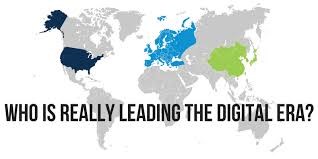Digital Hubs and the Consumer Internet—A Global Race
We are reading a lot about the two Internets—the closed one and the open one. China has its own Internet effectively. Russia has announced it will soon have a separate one as well. Yet functionally, China’s Internet is quite different from Russia’s. One is business-oriented, driving an emerging digital economy, the other is a vast Internet consumption machine. Which is which? Read on...

The World Economic Forum has been tracking these two “functional” Internets for some time, ranking each country on business and consumer indicators of Internet and ICT use. Beginning with the BRICS, Russia ranks 40 among countries on the consumer side of the ledger, 27 positions ahead of its business use rank. China is 44 on the business side—more than 30 positions ahead of its consumer rank. Two quite different digital profiles. Even more attention-drawing, South Africa ranks higher than China on the business side (32)—as do Indonesia (34) and the Philippines (36)—with all three countries much lower in their consumer rankings.
Staying with the BRICS, Brazil is evenly positioned as a consumer and business user country, ranking 57 on one and 59 on the other, while India ranks 75 on the business side but much lower on consumer usage, reflecting slow Internet take-up in rural areas.. (Mexico ranks behind Brazil on both scales but only slightly in terms of business usage, making it more of a digital producer than consumer.) Other notable emerging markets are those of Bahrain, Saudi Arabia and Kuwait, all high on the consumption side (14, 21 and 32). By comparison, Panama and Jordan rank 39 and 41 on the business side, well ahead of their consumption positions.
The advanced economies are similarly split between strong digital production platforms—Japan (3), the U.S. (4), Germany (6) and Israel (8)—and digital consumption machines like Denmark (1), the UK (5) and Norway (9). Remarkably, the Scandinavians, with the exception of Sweden, do not reflect B2B activity as much as some might think. As a group, they excel in digital consumption. This may be because their citizens almost all use English websites (50% of the world’s total) and there are few digital disparities by gender, age or location.
Switching continents, Korea, Hong Kong and Singapore, which many would assume to be digital producer countries all fall in the middle with relatively similar consumer and business rankings. The same is the case for France, Canada and the U.A.E. B2B and B2C are equally pronounced.
At the low-income level, Sri Lanka, Kenya, Senegal, Rwanda and Ivory Coast are the most notable digital business leaders. Most of these countries have been pursuing digital hub strategies for a few years. By the same token, their rural populations often lag the urban coastal ones in knowledge of English, French or other global languages and in Internet use. Meanwhile, wealthier countries in North Africa like Morocco and Egypt have even lower consumer rankings and much lower business ones. Their recently announced digital strategies will take some time to implement.
The shortage of Arab-language websites may be a factor too.
All in all, the moral is that countries with global business languages like English, Mandarin, German, Japanese and French are leading the producer Internet while those using Arabic and Russian largely headline the consumer side. Countries like Korea, Brazil, Thailand and Vietnam fall somewhere in between.
 View Printer Friendly Version
View Printer Friendly Version